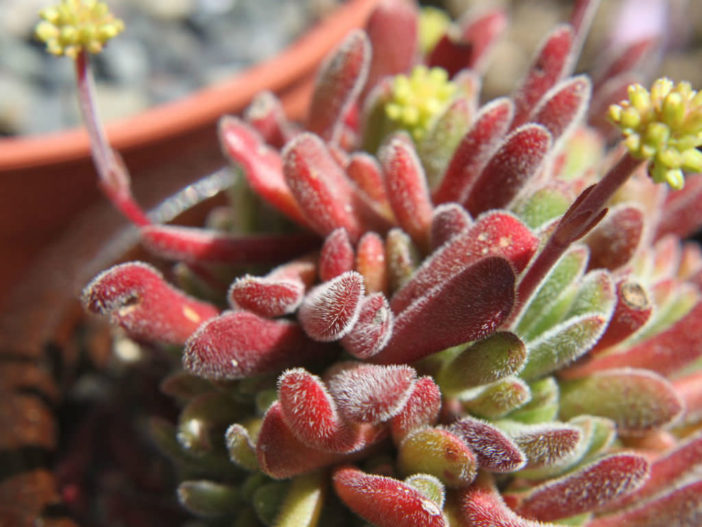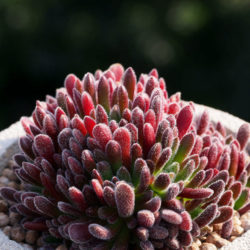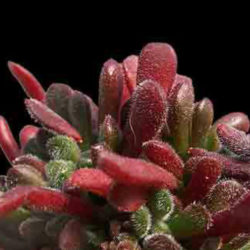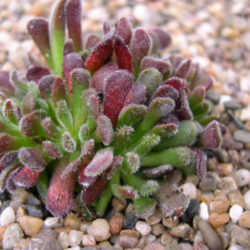Scientific Name
Crassula pubescens Thunb.
Common Name(s)
Jersey Pigmyweed, Bear Paw Jade, Red Carpet Crassula
Synonym(s)
Crassula pubescens subsp. pubescens, Globulea pubescens
Scientific Classification
Family: Crassulaceae
Subfamily: Crassuloideae
Genus: Crassula
Description
Crassula pubescens is a succulent shrublet with erect or spreading, non-rooting branches, rarely with basal rosettes and green, velvety leaves that turn red in full sun. It is usually much branched and grows up to 12 inches (30 cm) tall. The branches are often visible between leaves. Leaves are oblanceolate to obovate, rarely elliptic or linear, up to 1.2 inches (3 cm) long and 0.6 inches (1.5 cm) wide.
The fragrant flowers are tubular to almost cylindrical, cream to pale yellow, and appear in a few spherical to somewhat elongated clusters on an unbranched, up to 6 inches (15 cm) tall stalk in spring.
Origin
Crassula pubescens is native to South Africa. It occurs from near Worcester in the Western Cape to Willowmore in the Eastern Cape province, mainly in the Little Karoo and the adjoining mountains, growing on rocky slopes or often in rock crevices.
Etymology
The specific epithet "pubescens (pew-BES-senz) means "hairy" and refers to the hairy foliage of the species.

Hardiness
USDA hardiness zone 9b to 11b: from 25 °F (−3.9 °C) to 50 °F (+10 °C).
How to Grow and Care
Crassulas are easy to grow but susceptible to mealy bugs and fungal diseases. Overwatering is sure to be fatal, as with all succulents, so err on the side of too dry rather than too wet. Never let your Crassula sit in water. If you water from beneath by letting the plant sit in a saucer of water, ensure to pour off any excess water after a few minutes.
Crassulas are generally started by division, offsets, or leaf cuttings. Plants can be easily propagated from a single leaf: sprout leaves by placing them into a succulent or cacti mix, then covering the dish until they sprout.
Repot as needed, preferably during the warm season. To repot a succulent, ensure the soil is dry before repotting, then gently remove the pot. Knock away the old soil from the roots, removing any rotted or dead roots. Treat any cuts with a fungicide. Place the plant in its new pot and backfill it with potting soil, spreading the roots out as you repot. Leave the plant dry for a week or so, then begin to water lightly to reduce the risk of root rot.
See more at How to Grow and Care for Crassula.
Subspecies
Links
- Back to genus Crassula
- Succupedia: Browse succulents by Scientific Name, Common Name, Genus, Family, USDA Hardiness Zone, Origin, or cacti by Genus
Photo Gallery
Click on a photo to see a larger version.


